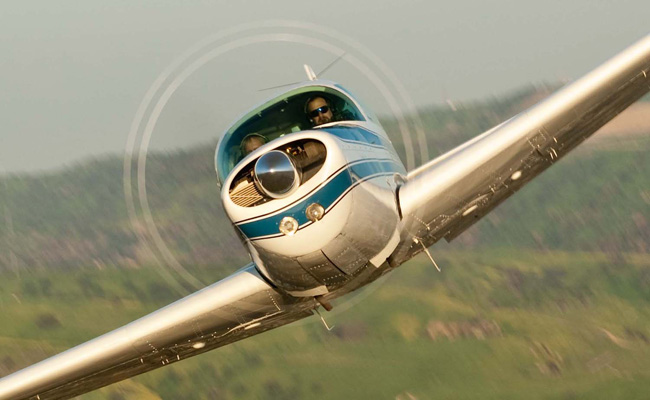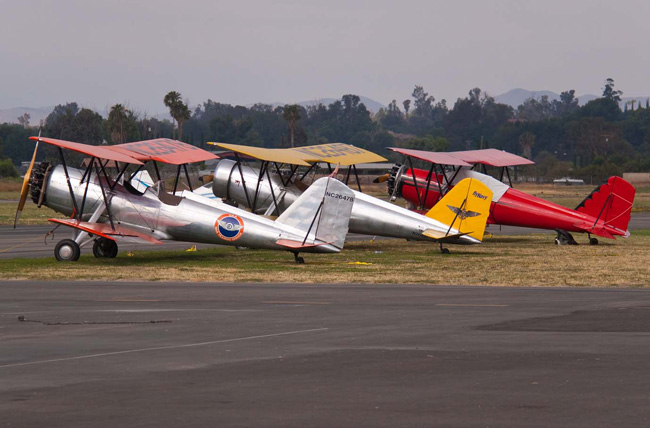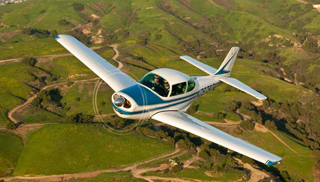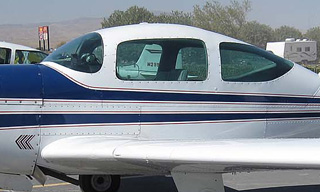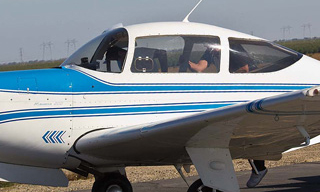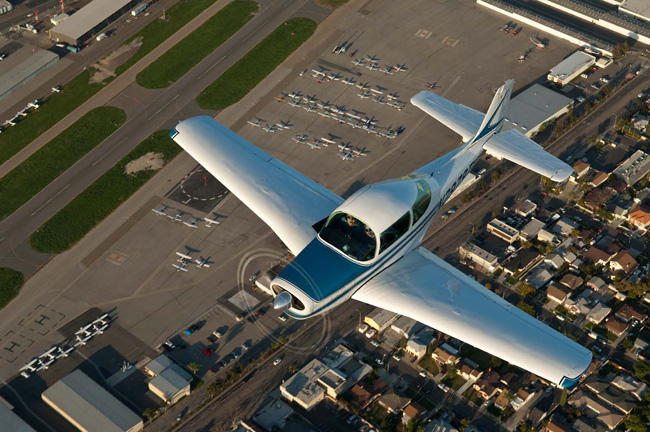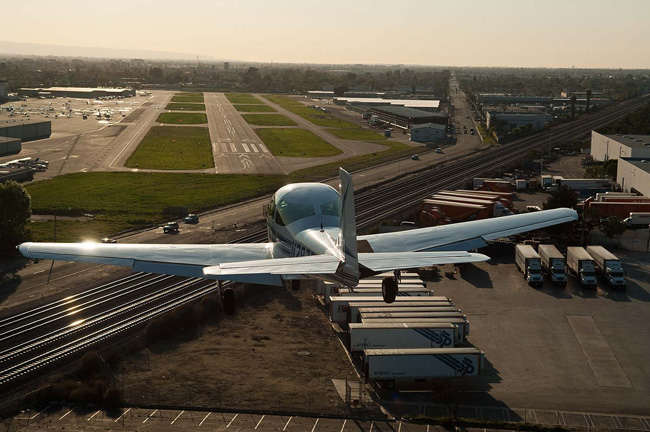This
eFLYER was developed in HTML for viewing with Microsoft Internet Explorer
while connected to the Internet: View
Online.
To ensure delivery to your inbox, please add eFLYER@barnstormers.com to
your address book or list of approved senders.
|
 |
ISSUE 314 - March 2014
Over 9,000 Total Ads Listed
1,000+ NEW Ads Per Week |
Meyers 200 Aircraft |
By Dean Siracusa, Austin, Texas, USA |
|
| Beginning the overhead break in a Meyers 200. |
Most younger aviators today aren’t familiar with the rare Meyers 200 that was built in the 1950s through the late 1960s but they should. Many confuse the Meyers 200 with the much larger and slower Ryan Navion but there’s absolutely no relation to its design or construction. The 200 was designed by Al Meyers to be the fastest and yet safest high performance, complex airplane available. Most of them will honestly cruise between 175 and 185 knots on 75% power and with a very high redline, yellow arc and gear extension speed they’re also very forgiving and relatively easy to fly. |
|
| A Meyers 200D climbing out on departure. |
|
| The rare Interceptor 400. A pressurized turboprop speedster that cruised at 300 knots. |
The Meyers 200 is such a strong airframe that a company in the early 1970s bought the type certificate and pressurized the fuselage and added a turboprop for a 300 knot cruiser. While this turboprop versions known as the Interceptor 400 was certified, they only built a couple of them. It was unfortunately, ahead of its time. |
|
|
Aircraft designer and builder Al Meyers in the 1930s (left). Meyers OTW originally used for the Civilian Pilot Training Program from WWII now a popular barnstorming plane (right). |
Al Meyers worked for such aviation luminaries as Chance Vought, Glenn Martin as well as the Stinson Aircraft Company before starting his own company. His first design was the Meyers OTW which stood for Out To Win. It was a biplane with a metal fuselage and a metal, wood and fabric wing. It was designed specifically as a primary trainer and first flew in 1936 and certified by the CAA in 1939. Several hundred were produced for the Civilian Pilot Training Program to train pilots during World War II. It was so well built and easy to fly that it had the reputation for never having a fatality with a student pilot of that era. A very rare claim in the early days of aviation. |
|
| A group of Meyers OTWs at a recent Fly-In. |
After World War II Al Meyers set his sights on building something faster that the post-war businessman might like to fly on cross country trips. His first design was the two seat Meyers 145. The fuselage and part of the wing and carry-through structure was 4130 chrome-moly steel tubing and covered in aluminum (similar to a modern Mooney). So strong was the airframe that in early spin testing Al Meyers got into a spin that he couldn’t recover and had to bail out with his parachute. The aircraft pancaked into the ground but the fuselage wasn’t significantly damaged so he made repairs and modifications (to improve spin and stall performance) and continued with testing. It was certified in the late 1940s and was famous for being able to cruise at 140 knots on a 145 horsepower Continental engine. Al built 12 of these before realizing that a four seat plane would be more popular and useful to the cross-country flying businessman. Al’s primary goals with all of his later aircraft was Safety and Speed. Design the plane to be as fast as possible and as safe as possible. |
|
| Dan Betzoldt putting his rare Meyers 145 back in the hanger after a flight. Dan’s father Ray worked for Meyers Aircraft Company as an engineer and test pilot. |
Al Meyers scaled up the fuselage to fit a big-bore Continental engine and to comfortably seat four people as well as a separate baggage area. The clean, laminar flow wing and fully enclosed landing gear were unusual for the day. It has very smooth lines that are similar to the modern Lancairs. That company was founded by Lance Neibauer in 1981 as a producer of composite homebuilt aircraft kits. Neibauer had been introduced to aviation by his uncle Ray Betzoldt, who had collaborated with Al Meyers to build the Meyers 200. Whenever he visited his aunt and uncle, he always took a ride in the Meyers. |
|
| Low approach in a Meyers 200 at a remote airport. |
The Meyers 200 was certified in the late 1950s and Meyers Aircraft built them until 1965 when Aero Commander bought the company and moved production to Albany, Georgia. Up till that time Meyers Aircraft were built one at a time by highly skilled aircraft engineers. Aero Commander’s goal was to create them on a modern assembly line. They built them for just over two years before ending production themselves and moving on to design and build the Commander 112 a much slower yet stately aircraft. All told only 127 Meyers 200s were built by Meyers and Aero Commander. |
|
|
| Meyers aircraft were originally custom built for each buyer. Here are several of them in the Tecumseh, MI factory being built (left). One reason for their legendary strength is the steel fuselage and (right) the wing carry through structure that went out past the landing gear on each wing. |
The early Meyers 200s had Continental IO-470s which had 260 horsepower but many of these upgraded to the IO-520 that was available in later models. There’s even an STC for the IO-550 which is a popular upgrade. |
|
| One of the many reasons why the Meyers 200 is so fast is its laminar flow wing and clean lines. The landing gear is completely hidden when it’s up and the fowler-type flaps are on tracks, not hinged as on many aircraft. |
During the years the Meyers 200 was built many of them racked up FAI speed records, around-the-world flights and participated in various races such as at Reno. They were usually the ones to beat and most other aircraft in its category could never keep up. Jerry Mock, a Columbus, Ohio, homemaker, set several records in Women's racing in the Meyers 200D. She piloted a 200D to a new world speed record for 500 kilometers in Class C-1b. And Don Washburn, flying a standard production 200D, claimed a record of 239.5 mph (208.26 kts!!) in class C-1c over a 3 km course. |
|
|
| Their speed made them extremely popular with racers. |
Why is the Meyers 200 so fast? There are a number of features on this plane that weren’t seen until the modern composite aircraft that you see today. Things like a laminar flow wing, wing-root filets, fully enclosed landing gear and a tightly waisted empenage all help to contribute to its performance. Also unusual is the fact that the engine is not canted down and to the left as on most aircraft, to counteract P-factor. And, since most do not have a rudder trim this means pressure on the right rudder is needed for take-off or you’re off into the weeds. But, it’s not really as bad as it sounds and Meyers owners get used to it very quickly. And its large rudder is very effective and it slips quite nicely. It’s also designed so that very little if any rudder is needed in turns while at cruise speeds. |
|
|
Early Meyers 200s have a smaller windshield and slightly lower roofline (left). Later versions had a larger windshield but they remained just as fast since they also incorporated flush rivets on the entire wing surface (right). |
Other things that make it popular with its owners are ailerons and elevator are controlled with torque tubes instead of cables. Also, large fowler-type flaps on tracks that go down to 40 degrees for slower approach speeds than most other high performance singles. A high gear extension speed and reasonable flap extension speed. Its worth noting that in an emergency the gear can be extended even past its redline speed of 236 and the gear will come down. It’s also significant that there are no Airworthiness Directives on the fuselage of the 200 (or any of Al Meyers’ designs for that matter). This is one strong and well-built airplane! |
|
| The landing gear and tires are massive and with the generous prop clearance it means that grass and dirt runways are no big deal to the Meyers 200. |
In spite of not being built for more than 47 years parts are still available. It was originally designed as a low volume production aircraft so parts were either easily fabricated using tools any good machine shop would have, or they were off the shelf parts from other sources. The spinner is from a Cessna 205. The arm rests are from a 1950s Chevrolet sedan. And, that’s the way they came from the factory. Al Meyers realized that if minor things someone else created worked well in his plane, why not use them instead of reinventing every little piece. |
|
|
The Meyers 200 is roomier than most aircraft of its era by several inches in both width and height (left). The instrument panel is wide enough to easily accommodate duel instruments for both the pilot and co-pilot and many have been significantly upgraded with modern technology (right). |
There’s also a strong owner community with its own website: www.MeyersAircraftOwners.org . There are no dues (donations are appreciated) and on the site are sources for various parts and answers to mechanical issues as well as great articles about various Meyers aircraft that have been published in all of the great aviation magazines (all with permission from the original source).
We thank the owners of these great airplanes for working hard to keep them flying. |
|
| |
Visit www.barnstormers.com -
post an ad to be viewed by nearly 1,000,000 visitors per month.
Over 17 years bringing more online buyers and sellers together
than any other aviation marketplace.
Don't just advertise. Get RESULTS with Barnstormers.com. Check
out the Testimonials |
Copyright © 2007-2014
All rights reserved.
 |
|





